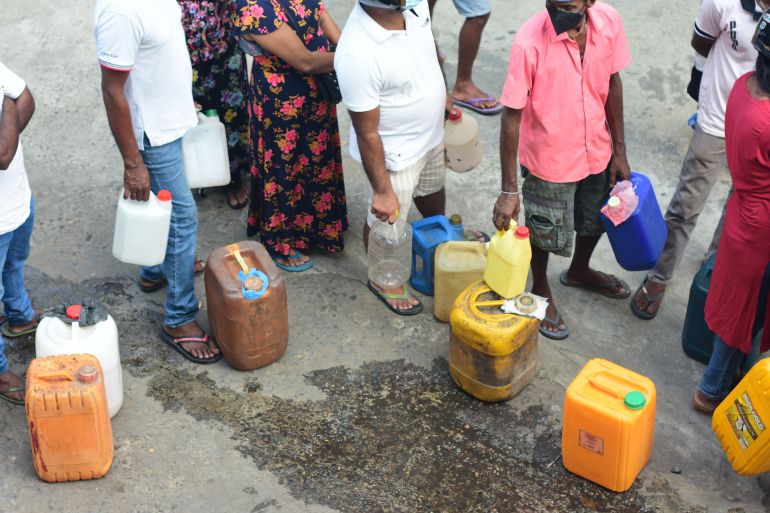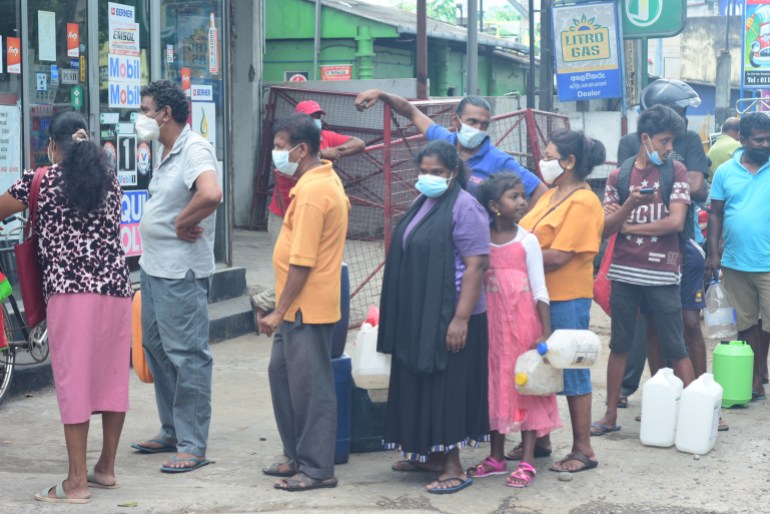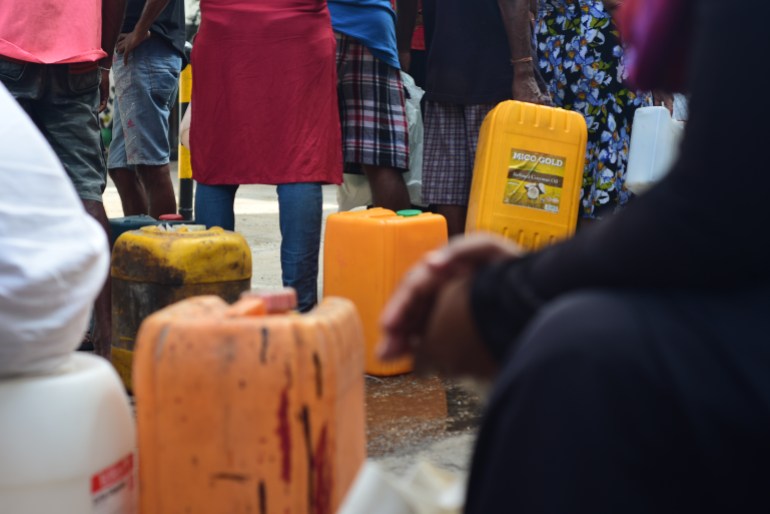Sri Lanka’s poor queue for hours to buy kerosene amid crisis
For months now, thousands have queued for fuel, food and medicine amid the country’s worst economic crisis since independence.

Colombo, Sri Lanka – Fatima Hussein has been standing in a queue for eight hours in scorching heat to buy kerosene at a petrol station in a busy suburb of the Sri Lankan capital.
A single mother of three children, Fatima says she has been queueing for kerosene at least twice a week for the past few months. On those days, she is unable to work.
Keep reading
list of 4 itemsSri Lanka president revokes emergency order amid deepening crisis
Photos: Sri Lanka protesters defy curfew after social media ban
Can the dire economic crisis in Sri Lanka be solved?
“If I don’t work, I don’t get paid. I make around 1, 200 rupees a day and bear all expenses of the family. All my children are in school and their expenses are mounting,” she told Al Jazeera.
Priced the cheapest among all fuels, at 87 rupees a litre (less than 30 US cents for 34 fluid ounces), kerosene is the preferred fuel of the urban poor, estate workers and fishermen in Sri Lanka. These communities use kerosene for cooking, lighting and, in the case of fishermen, to power their boats.
“We use kerosene to cook and even for lamps to save money on electricity. Gas has always been a luxury we could not afford,” said Fatima.
On the days she needs to buy kerosene, Fatima said she arrives at the fuel station by 7am. “There is a long queue even at that time,” she said.
“We wait in line under the hot sun. I bring a bottle of water. I can’t afford to buy food. We stand close to each other, tightly packed, and wait,” she said.
“The government says people must maintain social distancing because of the threat of COVID-19. They don’t care about us because we are poor. People are angry and frustrated and they have blocked the roads several times demanding fuel.”

For months now, thousands of Sri Lankans have queued for fuel, cooking gas, food and medicine amid the country’s worst economic crisis since independence in 1948, triggering spontaneous protests on the streets across the island demanding the resignation of President Gotabaya Rajapaksa.
On Sunday, shortly after thousands of people defied a state of emergency and curfew and joined street protests denouncing the government, the entire cabinet – except the president’s older brother, Prime Minister Mahinda Rajapaksa – resigned on Sunday.
In order to resolve the crisis, the president offered the opposition to join a unity government, but the main opposition party, the United People’s Force (SJB) has rejected the offer.
The Sri Lankan parliament met on Tuesday for the first time since the declaration of the state of emergency.
Meanwhile, as fuel prices rise due to the Russia-Ukraine war, the island’s stocks are running out. The foreign exchange shortage has also hit essential supplies, including food and medicine.
The price of petrol and diesel has almost doubled within a month. The price of LPG, commonly used for cooking by residents in urban areas, has tripled this year, forcing people to turn to kerosene.

H R Mohammed, 43, who has also been standing in a queue for kerosene for more than six hours, said he saw an elderly man collapse while waiting in the long line.
“Given that Ramadan fasting is to commence in a few days, many more will be victims of heat and exhaustion,” he told Al Jazeera last week.
The holy month of Ramadan, in which Muslims fast from dawn to dusk, started in Sri Lanka on April 2.
Mohammed, who drives an auto-rickshaw, says each day spent in kerosene queues adds to his financial troubles.
S A Wijepala, 66, a resident of Kiribathgoda, says while he does not like the taste of food cooked with kerosene, this is all he could afford.
A former employee of the Sri Lankan railways, he said his pension is barely enough to meet his basic needs amid high inflation.
“Late last year, we decided that we will have to switch to kerosene. This was even before gas prices went through the roof. Now a gas cylinder is over 4,000 rupees and this is beyond me. So, I am compelled to stay in line for hours and buy kerosene,” he said.
Bank employee Niroshani Perera says she carries several canisters to work and stands in line whenever she hears that kerosene is available at a station.
Niroshani said some government officials allege that most people in kerosene queues are hoarding it to sell it in the black market.
“These allegations are not only hurtful but also make people very angry,” she said. “The ministers and officials should be more sensitive to our struggles.”